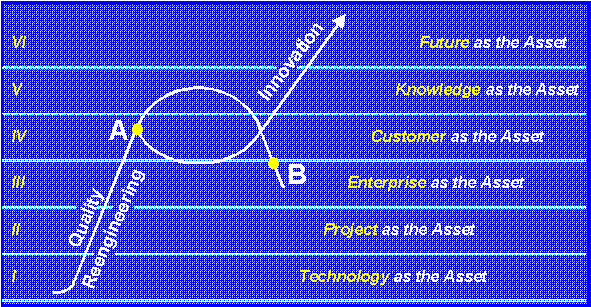 Paradigm
Shift
Paradigm
ShiftInternational
USA-505-586-1536
OtherWise
 Paradigm
Shift Paradigm
ShiftInternational USA-505-586-1536 |
OtherWise |
A new guest appears
monthly, and the prior wisdom is archived in the Library. |
Featured Guest Speaker Debra Amidon, Posted: March, 1999 Innovation
and the Knowledge Economy - |
 |
Attendance at a professional conference these days may leave the participant hard pressed to determine the sponsoring organization. The programs and even many of the presenters are identical to those of another discipline. Each professional orientation is broadening its purview. There is a realization of, and respect for, alternative paradigms that did not exist a decade ago. Many of these professions appear to have a common agenda: to understand and optimize the learning capacity of an enterprise so as to enable the optimal creation and application of new knowledge (i.e., the process of innovation). The trend in many disciplines is a convergence on three interrelated domains: economics, behavior, and technology. Meanwhile, each of these domains is broadening the scope of its theory and integrating core principles from the other domains into its practice. Cross-functional communities of practice in the form of collaborative consortiums, such as the Consortium for Advanced Manufacturing International (CAM-I), are becoming increasingly popular. The objective of such groups is to work together cooperatively in a precompetitive environment to solve problems that are common to a particular interest group, regardless of individual position, title, organization or background. Participative research, targeted intellectual efforts and human networks, the hallmarks of organizations like CAM-I, allow the participants to leverage ideas, concepts and resources. Fueled by advancements in computer and communications technology, informal and boundaryless communities of practice are evolving at a rate, and with a sense of self-organizing energy, that would be difficult to mandate. Even the best planning process does not provide for an understanding of such natural connections. Modern managers must take notice of these streams of activity to optimize the innovation process, where ideas originate, are exchanged, and eventually result in marketable products and services. Innovation Becomes the Glue The language and methodology of innovation is becoming the glue that connects across functions, industries, and countries; providing the rubric under which organizations can better utilize their resources — financial, physical, human, and technical. This new focus on knowledge innovation creates a fusion of effort that ultimately translates into an increased standard of living for everyone. Instead of relating solely as competitors, organizations discover ways to collaborate that contribute to the success of one another. A 1997 research project reported 33 leadership case studies that illustrate the various dimensions of knowledge management [1]. In almost every case references are made to the need to create a culture of sharing, openness, learning, collaboration, trust and innovation. Peter Drucker claims innovation, and the ability to measure the performance thereof, is the one competence needed for the future. In a recent survey performed by Ernst and Young, innovation was the primary attribute most important to an organization’s future in both Europe and the United States. The next business wave beyond reengineering and quality is shaping up as innovation; and the agenda for the 21st century, according to Skandia's Leif Edvinsson, is managing the future. |
 |
| The Emerging Wave of
The Sixth Generation Source: Cited in Power of Innovation. Supplement to Skandia’s 1996 Interim Report: 8. |
| Creating a collaborative culture
where knowledge is valued and shared effectively is one
of the most difficult challenges faced in practice;
principally due to our heritage of polarized competition.
Of primary importance is a common language of
innovation — a language that transcends the paradigm
and biases of one function or another. The knowledge base
from which organizations might learn is expansive when
looked at as a Strategic Business Network, depicted in
the accompanying figure. The dynamics of the economic environment demand a fluid, networked organizational structure that balances accountability with responsible risk taking. It is not the parts themselves that add value, but the synergistic nature of the whole. This is the nature of fusion and the result of symbiotic learning networks, both human and technical. Value resides in the interfaces between the boxes, sometimes described as the white space, which must be the object of our performance management systems. Finally, shared purpose is essential for an enterprise to thrive in this fast changing global economy. Amidst the turmoil and chaos of the past decade, throughout downsizing and reengineering processes, many organizations have lost their sense of direction. Initiatives have become fragmented and, worse still, internally competitive. Interestingly enough, it may not be the financial resources that are scarce today as much as the mind-share and available commitment time of enterprise leaders. Too often managers operating in the traditional, competitive work climate are managing initiatives with unnecessary duplication of effort and suboptimal allocation of resources. In many instances organizations must find a way to coalesce, rededicate themselves to a common agenda, and respect the complementary competencies that can be brought to bear. Creating the community of innovation practice is one way to begin the process. |
|
Strategic Business Network - Source: Adapted from [2] |
| Getting Started The Knowledge Innovation™ Litmus Test below can help you assess your organization's capacity for innovation, and also help you get an internal dialog started. This quick test was first published in Innovation Strategy for the Knowledge Economy [2], which offers over 70 questions for a full assessment. Answer these questions individually or in a group. Using this as a dialogue tool, participants will get a better understanding of the complementary competencies that can be brought to bear on innovation. |
| Yes | No | Knowledge Innovation™ Litmus Test |
| [ ] | [ ] | 1. Has one person been chartered with the overall responsibility to manage the corporate-wide innovation process? |
| [ ] | [ ] | 2. Are there performance measures — both tangible and intangible — to assess the quality of the organization’s innovation practices? |
| [ ] | [ ] | 3. Do the training/educational programs have provisions to incubate and spin out new products and businesses? |
| [ ] | [ ] | 4. Does the local, regional, or international presence operate as a distributed network of expertise which learns from as well as distributes to customers? |
| [ ] | [ ] | 5. Is there a formal intelligence gathering strategy to monitor the positioning of both current and potential competitors? |
| [ ] | [ ] | 6. Does the rate of production of new products and services exceed the industry norms and create new markets in which to excel? |
| [ ] | [ ] | 7. Has a strategic alliance manager been designated to create and manage the network of partnerships and joint ventures to leverage the firm? |
| [ ] | [ ] | 8. Does your marketing image portray an organization with the capacity to create and move ideas into the marketplace to make the firm’s customers successful? |
| [ ] | [ ] | 9. Have resources been allocated to articulate a compelling vision internally and share company expertise externally through publications and participation in major forums? |
| [ ] | [ ] | 10. Is the computer/communications capability treated as a learning tool for internal conferencing and external business leverage on the Worldwide Web? |
| If seven out of the ten questions were
answered in the affirmative, it is likely the
organization has a good handle on the innovation process
and knows how to create an environment for the optimal
flow of ideas. Primarily negative responses to these
questions should drive an organization to examine its
processes for bringing ideas to market and leveraging
intellectual capability into the future. Even if the
score is high, the questions can frame an innovation
dialogue. Conclusion The foundation for a new economic order is already laid. This does not mean the answers are all known, but there is an understanding of the necessary infrastructure and the right questions to be addressed. The knowledge economy is a very different paradigm from previous agricultural, industrial, or service economies. It is one that rests on the value of human potential and how it might be systematically leveraged for the benefit of mankind. The challenge is to determine the integral linkage between human potential and economic performance. The knowledge economy affords an unprecedented opportunity for creating the future. This is a climate in which ideas will be valued, but only as they are applied to advance society, however that may be defined. The answers lie in an effective innovation strategy, redefined according to the flow of knowledge. Management responsibilities will be viewed as facilitating the learning process, for internal as well as external stakeholders such as suppliers, distributors, alliance partners, customers, and even competitors. How these relationships are managed is far more a matter of collaborative expertise than the competitive skill with which most are familiar. Values, valuation and valuing will gain prominence as executives search for what to measure, and how and when to evaluate performance. Only when we have a common language across borders — functions, industries and countries alike — can we begin to explore the prospects for collective prosperity. With the emerging community of innovation practice, it is understood that various practitioners throughout the value system can contribute. How they are engaged in a common mission determines how they are able to leverage their complementary competencies. Rather than competing for resources and spheres of influence, individuals, groups, organizations and nations can realize what they have to gain through collaborative rather than competitive strategy. The core premise of the future is collaboration. This does not mean that organizations do not compete; competition is inevitable. It does mean that the orientation shifts to one of sharing and leveraging one another for mutual success. In national and global terms, this is described as creating the common good from which all benefit. Previous eras have experienced reliance upon resources that are depleted. Perhaps the era based upon the bountiful resource of knowledge provides an opportunity for true global symbiosis. References [1] Skyrme, David J, and Amidon, Debra M., Creating the Knowledge-Based Business, Business Intelligence, London, England, 1997 [2] Amidon, Debra M., Innovation Strategy for the Knowledge Economy: The Ken Awakening, Butterworth Heinmann, Newton, MA, 1997 Debra Amidon, President, Entovation
International |
| Would you like to offer some thoughts or add to the dialog? Responses of general interest may be posted below.
Send your comment to |
| =========
Reply ========================= |
|
Send mail to |